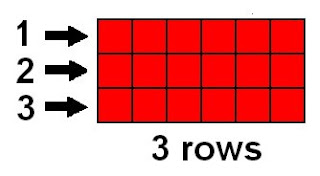Time to get back to the basics of rectangles. A rectangle is a quadrilateral (4 sides) with 4 right angles. Students were given 7 rectangles of various sizes in class and asked to sort them in order from least to greatest. As always, all manipulatives and materials were available for students. Once the mad rush for rulers ended, I began hearing students arguing in their small groups about the order of the rectangles. Some put them in order by height, some by width, some by “eyeballing” the size. Then, I overheard a group ask “What about the stuff on the inside of the rectangle? Some of them have more room on the inside.” And thus the area conversation was born.
We use square tile manipulatives to determine the area of shapes in second grade. Students began covering the rectangles with tiles. They were then able to put the rectangles in order from least to greatest by counting the tiles on the rectangles.
This caused another problem. Students had to figure out a way to describe what they did so that another group could recreate it. In class, when we try to recreate something, we say that we are making congruent shapes. (We are making shapes that are the same exact shape and same exact size as the shape described.) We discovered that this was impossible to do without using a common vocabulary.
We began to look at our rectangles as arrays. An array is simply an arrangement of rows and columns. We determined that we would call the vertical parts or our array columns and the horizontal parts rows. We were then all finally able to put the rectangles in order from least to greatest.
We are still new to rectangles, so it may take a little practice to master columns and rows. I was not able to find much online by way of rectangle games. I am attaching 1 inch graph paper to this post to use to print and practice at home.
You can use this paper several different ways:
-Cut out the squares and use them to create arrays to practice counting the areas. Play different games such as giving your child only a certain amount of squares to use for each rectangle and seeing how many different rectangles they can make. You could also tell your child the number of columns and rows and have your child recreate the array.
-Draw different arrays on the graph paper and count the number of columns and rows.
-Cut out several large rectangles and have your child practice putting them in order from least to greatest.
Online practice finding area.



No comments:
Post a Comment